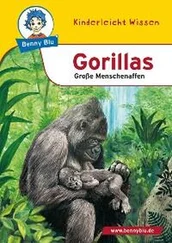Richard Garner - Gorillas & Chimpanzees
Здесь есть возможность читать онлайн «Richard Garner - Gorillas & Chimpanzees» — ознакомительный отрывок электронной книги совершенно бесплатно, а после прочтения отрывка купить полную версию. В некоторых случаях можно слушать аудио, скачать через торрент в формате fb2 и присутствует краткое содержание. Жанр: foreign_antique, foreign_prose, на английском языке. Описание произведения, (предисловие) а так же отзывы посетителей доступны на портале библиотеки ЛибКат.
- Название:Gorillas & Chimpanzees
- Автор:
- Жанр:
- Год:неизвестен
- ISBN:нет данных
- Рейтинг книги:3 / 5. Голосов: 1
-
Избранное:Добавить в избранное
- Отзывы:
-
Ваша оценка:
- 60
- 1
- 2
- 3
- 4
- 5
Gorillas & Chimpanzees: краткое содержание, описание и аннотация
Предлагаем к чтению аннотацию, описание, краткое содержание или предисловие (зависит от того, что написал сам автор книги «Gorillas & Chimpanzees»). Если вы не нашли необходимую информацию о книге — напишите в комментариях, мы постараемся отыскать её.
Gorillas & Chimpanzees — читать онлайн ознакомительный отрывок
Ниже представлен текст книги, разбитый по страницам. Система сохранения места последней прочитанной страницы, позволяет с удобством читать онлайн бесплатно книгу «Gorillas & Chimpanzees», без необходимости каждый раз заново искать на чём Вы остановились. Поставьте закладку, и сможете в любой момент перейти на страницу, на которой закончили чтение.
Интервал:
Закладка:
It is said by some that the skin is light in colour when young, and becomes darker with age, but such is not the case. It is true that the skin darkens a few shades as the cuticle hardens, but there is no transition from one colour to another, and this slight change of shade is only on the exposed parts.
The kulu has a short, round face, very much like that of a human. In early life it is quite free from hairs, but, like the other, a slight down appears with age. He has a heavy suit of hair on the body. It is coarser than that of the ntyigo , longer, and inclined to wave, giving it a fluffy aspect. The colour is jet black, except a small tuft of white about the base of the spine.
The skin varies in colour less than in the ntyigo , and the darker shades seldom appear. The eyes are a shade darker, and in both species the parts of the eye which are white in man are brown in the chimpanzee, gradually shading off into a yellow near the base of the optic nerve. As a rule, the kulu has a clear, open visage, with a kindly expression. It is confiding and affectionate to a degree beyond any other animal. It is more intelligent than its confrère , and displays the faculty of reason almost like a human being.
One important point in which these apes differ is in the scope and quality of voice. The kulu makes a greater range of vocal sounds than the other. Some of them are soft and musical, while those uttered by the ntyigo are fewer in number and more harsh in quality. One of them resembles the bark of a dog, and another is a sharp screaming sound.
The kulu evinces a certain sense of gratitude, while the ntyigo appears to be almost devoid of this instinct. There are many traits in which they differ, but human beings, of the same family, also differ in these qualities.
The points in which they coincide are many, and after a brief review of them, we may consider the question of making two species of them, or assigning them to the same.
The skeletons, as we have noted, are the same in form, size and proportion. Their muscular, nervous, and veinous systems are the same, except a slight structural variation in the genital organs of the males, and the degree of mobility in certain facial muscles. The character of their food, and the mode of eating it, are the same in each. In captivity they appear to regard each other as one of their own kind, but whether they mate or not remains to be learned.
Such is the sum of the likenesses and differences between the two extreme types of this genus; but with so many points in common, and so few in which they differ, it is a matter of serious doubt whether they can be said to constitute two distinct species, or only two marked varieties of a common species. This doubt is further emphasised by the fact that all the way between these two extremes are many gradations of intermediate types, so that it is next to impossible to say where one ends and the other begins.
In view of all these facts, I believe them to be two well-defined varieties of the same species; they are the white man and the negro of a common stock. They are the patrician and plebeian of one race, or the nobility and yeomanry of one tribe. They are like different phases of the same moon. The kulu-kamba is simply a high order of chimpanzee.
It is quite true that two varieties of one species usually have the same vocal characteristics, and this appears to be the strongest point in favour of assigning them to separate species, but it is not impossible that even this may be waived.
Leaving this question for others to decide, as they find the evidence to sustain them, we shall, for the present, regard them as one kind, and consider their physical, social and mental status.
Whether they be all of one species, or divided into many, the same habits, traits, and modes of life prevail throughout the entire group, so that one description will apply to all, so far as we have to deal with them in general. There are many incidents to be related elsewhere, which apply to individuals of the special kinds mentioned, but for the present the term chimpanzee is meant to include the whole group, except where it may be otherwise specified.
CHAPTER V
PHYSICAL, SOCIAL, AND MENTAL QUALITIES
Physically, the chimpanzee, as we have seen, closely resembles man, but there are certain points that have not been mentioned in which he differs from him, also from other apes. We may here take note of a few of those points.
The model and structure of the ear of this ape are somewhat the same as those of man, but the organ is larger in size, and thinner in proportion. It is very sensitive to sound, but dull to the touch, indicating that the surface is not well provided with nerves. He cannot move it as other animals move theirs by the use of the muscles at its base, but, like the human ear, it is quite fixed and helpless in this respect.
The hand of the chimpanzee is long and narrow. The finger bones are longer, in proportion to their size, than those of the human hand, and slightly more curved in the plane of the digits. One thing peculiar in the hand of the chimpanzee, is that the tendons inside of the hand, which are called the flexors, and designed to close the fingers, are shorter than the line of the bones, and on this account the fingers of the ape are always held in a curve, so that he cannot possibly straighten them into a line. This is probably due to the habit of climbing in which he indulges to a great extent; also to the practice of hanging by the hands. In making his way through the bush, he often swings from bough to bough by the arms alone, and sometimes suspends himself by one arm, while he uses the other to pluck and eat fruit. This characteristic is transmitted to the young, and is found in the first stages of infancy. The thumb is not truly opposable, but is inclined to close towards the palm of the hand. It is of little use to him. His nails are thick, dark in colour, and not so flat as those of man.
Instead of having the great toe in line with the others, it projects at an angle from the side of the foot, something after the manner of the human thumb. The foot itself is flexible, and has great prehensile power. In climbing, and in many other ways, it is used as a hand. The tendons in the sole of the foot are equal in length to the line of the bones, and the digits of the foot can be straightened, but both members are inclined to curve into an arch in the line of the first and second digits.
His habit of walking is peculiar. The greater part of the weight is borne upon the legs. The sole of the foot is placed almost flat on the ground, but the pressure is greatest along the outer edge of it, in the line of the last digit. This is easily noticed where he walks through plastic ground. In the act of walking he always uses the hands, but does not place the palm on the ground; he uses the backs of the fingers instead, sometimes only the first joints are placed on the ground, resting on the nails; at other times the first and second joints are used, while at others the backs of all the fingers from the knuckles to the nails serve as a base for the arm. The integument on these parts is not callous, like that of the palm; the colour pigment is distributed the same as on other exposed parts of the body, which shows that the weight of the body is not borne on the fore limbs, as it is in the case of a true quadruped, but indicates that the hand is only used to balance the body and shift the weight from foot to foot, while in the act of walking. The weight is not equally distributed between the hands and the feet.
His waddling gait is caused by his short legs, stooping habit and heavy body. All bipeds with stout bodies and short legs are predisposed to a waddling motion, which is due to the wide angle between the weight and the changing centre of gravity.
Читать дальшеИнтервал:
Закладка:
Похожие книги на «Gorillas & Chimpanzees»
Представляем Вашему вниманию похожие книги на «Gorillas & Chimpanzees» списком для выбора. Мы отобрали схожую по названию и смыслу литературу в надежде предоставить читателям больше вариантов отыскать новые, интересные, ещё непрочитанные произведения.
Обсуждение, отзывы о книге «Gorillas & Chimpanzees» и просто собственные мнения читателей. Оставьте ваши комментарии, напишите, что Вы думаете о произведении, его смысле или главных героях. Укажите что конкретно понравилось, а что нет, и почему Вы так считаете.












